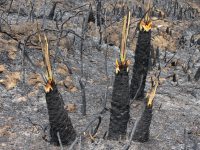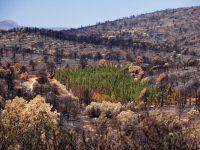The controversial effect of fire
Fire and the carbon cycle in Mediterranean ecosystems
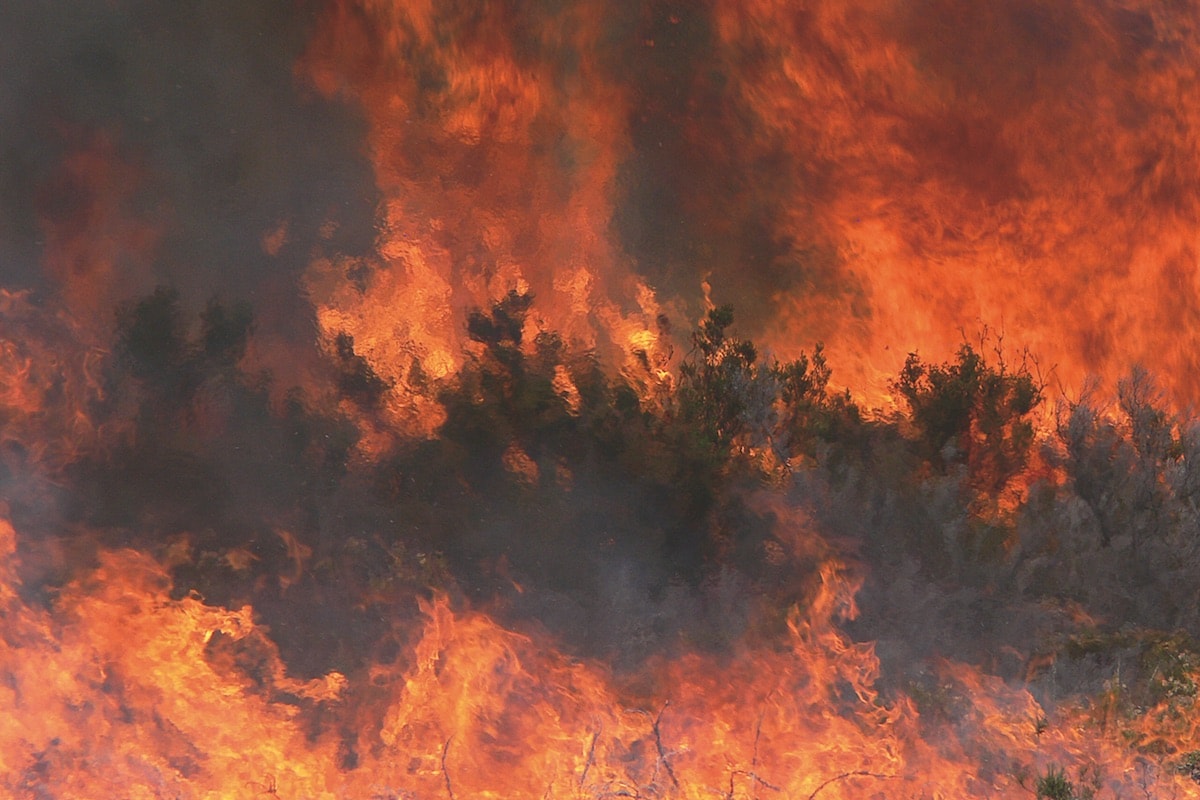
Organic matter is a key factor in soil fertility, hydrology and erosion; furthermore, its properties are affected by forest fires. Indeed, research shows that fire promotes the creation of new substances and speeds up mineralisation, also encouraging the production of recalcitrant forms of organic matter.
On a planetary scale, it is estimated that between 530 and 555 million hectares of forest land is affected by fire every year, this being equivalent to burning about 50,000 million tons of biomass per year. Forest fires are a global phenomenon systematically affecting tropical and subtropical forests, temperate rainforests, boreal forests, tropical savannas as well as farmland.
«Between 530 and 555 million hectares of forest land is affected by fire every year, this being equivalent to burning about 50,000 million tons of biomass per year»
The impact of fire on soil, besides giving rise to a selective loss or degradation of organic constituents, also determines a substantial increase in the molecular diversity of soil organic matter, whereby new structures appear that are not synthesised by either the vegetation or by microorganisms. Also, exothermic condensation reactions occur, producing effects involving the aromatisation of aliphatic carbon forms and the cycling of originally biodegradable nitrogen compounds. In short, fire creates new forms of organic matter.
Other side effects of fire, such as increased hydrophobicity of organic matter and the formation of irreversible bonds within the soil matrix –clays and iron and aluminium oxides– lead to increased condensation and structural complexity of organic matter. This, coupled with its polydispersity or the chaotic three-dimensional distribution of its components, makes it difficult to recognise in terms of specific soil enzymes. In fact, some authors have compared the biological or enzymatic maturation of soil organic matter –a process requiring hundreds or thousands of years– with the effect of fires. This is because the latter sometimes produces almost instant effects, hardly distinguishable from biotic processes typical of soil. Thus, fire accelerates both the changes and evolution of organic matter.
Therefore, scientific research investigates the quality –rather than quantity– of carbon sequestered in the soil. In particular, studying soil quality can give the most reliable measure of the soil’s resilience or capacity to undergo minimum change when subjected to environmental impact, such as climate change.
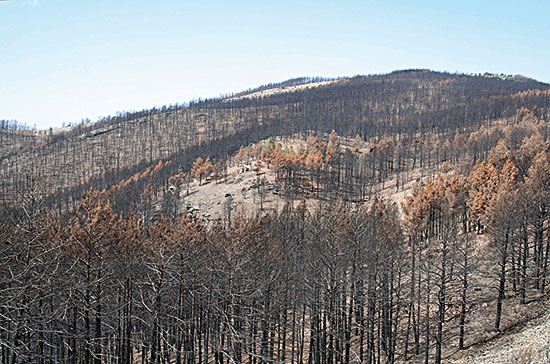
Fires in wooded plantations leave a desolate landscape, as in this picture of the Teruel fire in 2009. / A. Cerdà/Universitat de València
Fire, a positive or negative impact?
The history and management of fire relates to human ecology adapted to fire, with changes in the dominant paradigms regarding the causes and effects (catastrophic versus positive) of forest fires. The current frequency of fires is a consequence of human intervention in forest ecology, especially due to the reduction of herbivores, in relatively recent times, dating from 100,000 to 250,000 years ago. Similarly, regarding the nature of the effects of fire, it is generally accepted that its impact on the environment is disastrous. This idea is linked to the variations in chemical and physical parameters of the soils affected, where the extent of change usually exceeds by several orders of magnitude that produced by other anthropogenic disturbances. In particular, experiments based on comparing the effects of wildfires with those of controlled fires help to resolve the controversy over the varying effects of fire –some positive– on the biogeochemical cycle of soil and the quality of different forms of organic carbon, and thus attempt to selectively induce beneficial effects on the soil and reduce the adverse effects.
Forest fire research
The study of the effects of forest fires on ecosystems, particularly on the functioning of the soil, is a line of research to which special attention is paid worldwide, given the significant environmental effects of the phenomenon, recurring in certain phytosociological formations. Among the main research fields focusing on the effects of forest fires in soil systems, the following may be noted: fire and ecological succession; soil erosion and degradation and their impact on surface and subsurface hydrological processes; fire and hydrophobicity; physical fertility factors of soil; long-term accumulation of stable forms of carbon (black carbon and pyrogenic humus); molecular descriptors of the effect of fire on organic matter; enzyme activity and soil micro-fauna; arson associated with the economic interests of land use; fire and release to the atmosphere of volatile carcinogens or mutagens; and the planning and provision of fire-fighting and control services.
«Fire plays a recurrent role in accelerating the biogeochemical carbon cycle, destroying slow growing vegetation, but maintaining or even increasing the carbon content accumulating in the soil»
All of these general issues have led to the proliferation of an extensive bibliography and frequent international conferences. Among these, the series of conferences Forest Fires and Fire Research Ecology and Management have had a major impact, as well as specific workshops on the effects of forest fires in the latest conventions held at the European Geosciences Union (EGU, Vienna, 2002-2011) and the numerous conferences on environmental risks. Moreover, there is increasing interest, mirrored in the ever-growing number of specialised journals (Journal of Forest Fire Research, International Journal of Wildland Fire, Fire Safety, Fire and Materials or Fire Management Notes), and more and more articles on this topic in multidisciplinary journals dealing with soil science, ecology, forestry or environmental sciences. A compendium of these numerous references is included in the monthly publication Current Titles of Fire in Wildland Fire by the Research Institute of Arizona. Moreover, in many countries there are scientific societies with national specialists in the various aspects of research into the effects of fires, such as the Spanish network Fuegored, created in 2007 under the auspices of the Ministry of Science and Innovation.
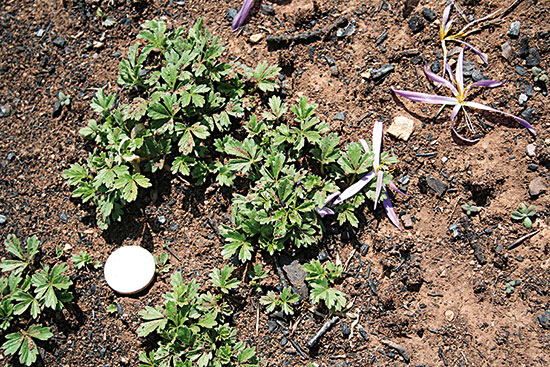
Twenty days after a fire, life returns. This is thanks to the soil accumulating nutrients, water and roots, tubers or seeds. / A. Cerdà/University of Valencia
Fire and the carbon cycle in Mediterranean soil ecosystems
The incidence of fires is particularly high in countries with a Mediterranean climate, which is recognised as one of the main forces behind the change in the structure and functioning of ecosystems. This is due to the characteristics of the semi-arid Mediterranean climate, such as a hot dry season, with water deficit in the soil. This means that the biochemical or enzymatic soil processes are discontinued, so that the biodegradation and humification mechanisms take place during barely two or three months each year, which significantly slows down the carbon flow and especially the release of nutrients needed to recharge the soil solution. Under these conditions fire plays a recurring role in the acceleration of the biogeochemical carbon cycle, destroying slow-growing vegetation, which recovers in a few years, releasing nutrients in the ash, while retaining or increasing the carbon content accumulated in the soil.
Furthermore, typically Mediterranean plant species are highly flammable due to low water content and the relatively high concentration of combustible essential oils. In addition, these ecosystems frequently include pyrophytes with anatomical or physiological adaptations that allow them to resprout subsequent to fire.
While highly active biological ecosystems, such as tropical forests, show zero or a negative balance in carbon accumulation in the soil because of the continuous biological activity –and because the carbon in the atmosphere is sequestered mainly in biomass and not in the soil– in semi-arid ecosystems the accumulation of black carbon, coupled with the formation of recalcitrant humic substances, hardly recognisable by enzymes, is an abiotic process crucial to the progressive stabilisation and accumulation of carbon in the soil.
Lastly, in Mediterranean ecosystems there are socioeconomic factors that contribute to the increased number of fires in some scenarios. These include the maintenance of traditional practices (the burning of stubble and other crop residues) or the exodus of rural population, which has caused the abandonment of agricultural land and traditional practices of sustainable exploitation of forests. Among these factors, we must not forget that many fires are caused deliberately.
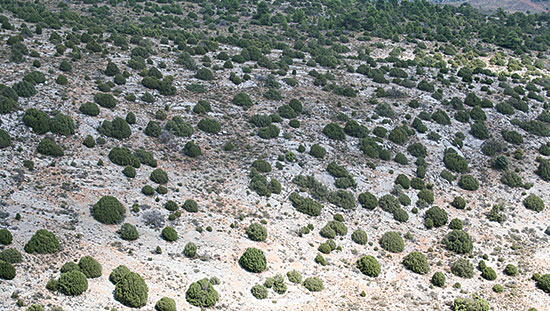
The presence of livestock breaks up the brush or ground cover and hence allows fire to be controlled. / A. Cerdà/University of Valencia
The future of research on the impact of wildfires
Monitoring the effects of fire on soil properties is a key factor in designing strategies for rehabilitation and restoration of affected areas. In this respect it is essential to study the impact of fire on soil in greater depth, specifically the change that organic matter undergoes, and particularly focusing on molecular analysis of changes that affect the forms of carbon in soil, above all the so-called humic substances.
So far, studies on organic matter in soil have contributed to a neutral view of fire as a factor that in itself is not a progressive or regressive factor in the evolution of ecosystems at a global level. Since fire is a major abiotic factor in the molecular diversity of organic matter in soil, the study of fire-related changes helps us to correctly interpret environmental processes, enabling us to infer the quality of ecosystems and soil health, which are recorded in the molecular composition of organic matter, mainly in lipids and humic substances.
Studies into fire-related changes in organic matter are also of definite practical interest, since the composition of humus can be used as an indicator of recovery at times when soils are affected by forest fires. Past studies focusing on the difficult identification of molecular descriptors or proxies of the incidence or intensity of soil changes provided few quantitative or qualitative descriptors of particular diagnostic value, nor could they be generalised to different ecosystems. Among these proxies one should note benzenecarboxylic acid formation, furfural generation, cyclisation of the amide form of N, or the destruction or insolubilisation of perylene quinones. Recently it has been proven that changes in carbon preference rates (ratio between alkyl molecules with an odd or even number of carbon atoms) and average length of linear lipid chains of soil (mainly linear hydrocarbons and fatty acids) can serve as a valid measure of the degree of recovery at the time soils are affected by fire.

Large forest fires are linked to land abandonment. In the picture, the ravine of Fos or Tarongers between Bocairent and Ontinyent. The abandoned terraces and mill are silent witnesses of time and changes in land use. / A. Cerdà/University of Valencia
Therefore, heat causes the originally biodegradable organic matter in soil to stabilise for extended periods and form new humic-type substances that do not exist in living organisms. Fires cause changes in the microstructure of the soil, triggering hydrophobicity or water repellent processes, but also by increasing the stability of the bonds between organic and mineral matter. Intense fire also determines the loss of many functional groups of organic matter (mainly carboxyl), the new formation of cyclic or condensed structures, and the polymerisation of soluble precursors involving structural alterations of biomacromolecules (cellulose, lignin…) that make them less easily biodegradable as they become unrecognisable to enzymes. In fact, some of the most stable forms of organic matter in soil are generated rapidly under the effect of fire, as is the case of pseudo-melanoidins, or macromolecules from thermal dehydration of carbohydrates (charred material); the formation of Maillard products, based on nitrogen and carbohydrate products; the condensation of lipid compounds that resinify or are incorporated in other forms of organic matter structure; and the accumulation of products from carbonisation of lignocellulosic biomass –generically known as black carbon–. Although the latter can biodegrade in a reasonable length of time under tropical conditions and when thinly divided, it may constitute a significant proportion of soil carbon, which is very difficult to quantify by conventional analytical techniques.
Thus we show it is necessary to study in depth the molecular basis of the structure of organic matter in soil (non-destructive spectroscopic, chemotaxonomic and metabolomic approaches), and the selective effect of fire on biogenic and diagenetic routes that contribute to the natural processes of stabilisation of carbon forms in the soil.
REFERENCES
Almendros, G. et al., 1990. «Fire-induced Transformation of Soil Organic Matter from an Oak Forest: an Experimental Approach to the Effects of Fire on Humic Substances» Soil Sci, 149:158 - 168.
González-Pérez, J. A. et al., 2004. «The Effect of Fire on Soil Organic Matter-a Review». Environ. Int., 30: 855-870.
González-Vila, F. J., & G. Almendros, 2003. «Thermal Soil Organic Matter Transformation of Natural Fires and by Laboratory-controlled Heatings». In: Ikan, R. (ed.). Natural and Laboratory Simulated Thermal Geochemical Processes. Kluwer Academic Publishing. Dordrecht.

